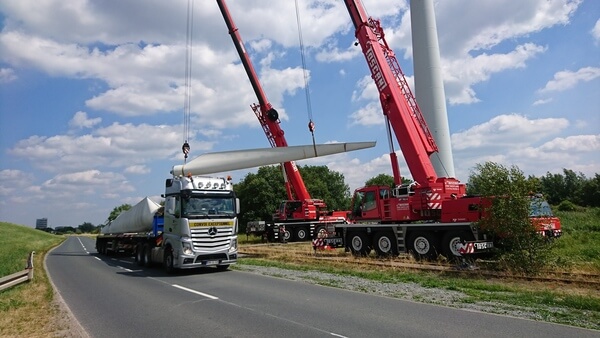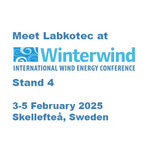News Release from Fraunhofer-Institut für Fertigungstechnik und Angewandte Materialforschung IFAM
Wind Industry Profile of
Practical test passed: Shark skin varnish increases the electricity yield of wind turbines
One approach was to reduce air resistance. In aircraft construction, it was shown that the functional coating developed at Fraunhofer IFAM with microscopically small grooves – called riblet paint – reduces air resistance and saves fuel. The scientists took advantage of this know-how and adapted the technology to the rotor blades of a wind turbine. The tests under real conditions yielded promising results.
It seems that sharks glide through the water at high speed without much effort. Microscopically small grooves on their skin help them to achieve this remarkable speed. This is due to the friction-minimizing property of the microstructure, which optimizes the hydrodynamic properties of the fish body. The effect is based on a reduction of turbulent vortices within the boundary layer and leads to a reduction of the frictional resistance. In fluid mechanics, shark skin longitudinal groove structures have been used in a variety of ways for several years.
Functional coating reduces flow resistance in the water and in the air
In order to transfer the principle of shark skin to technical applications, in the beginning mainly grooved adhesive foils were used for experimental purposes. For applications on curved surfaces or requiring high durability under harsh environmental conditions, the use of the film is difficult. For this reason, the Fraunhofer IFAM has developed a coating solution in which a liquid coating is applied, finely grooved and cured in a single work step. In the past, the aerodynamic benefits of these paint surfaces have been proven for various large-scale applications, especially in aviation and shipping. But how does the system behave in wind turbine generators and how can it be applied to increase the electricity yield in new turbines as well as retrofitted to existing plants?
Automated coating of riblet paint on rotor blades
Prior to the project, wind tunnel tests on the influence of the Riblet paint system on the aerodynamic properties of a model rotor blade profile had been carried out and led to promising results in terms of performance increase. On the basis of these results, it was predicted that the Fraunhofer IFAM paint system would significantly improve the aerodynamic quality of the rotor blades – without additional loads for the design of the wind turbine, since the performance-enhancing function is integrated into the paint system.
As a first step of the "Riblet4Wind"project, another comprehensive wind tunnel test series on a 2D airfoil with riblets was carried out by bionic surface technologies. A significant aerodynamic efficiency increase of 10% was measured.
Within the subsequent demonstration phase of the project, each partner had a special task in adapting the Riblet system to the large structures of the rotor blades: bionic surface technologies GmbH determined the optimum geometry for the selected wind turbine using flow simulation and wind tunnel tests, engineers from Mankiewicz developed the paint system, Fraunhofer IFAM provided the paint applicator, which was combined with robotics from Eltronic adapted for rotor blade coating to form an automated application system. An existing wind turbine, a AN Bonus with a rated output of 450 kW and a rotor diameter of 37 meters, was used to demonstrate the technology. Together with a sister turbine of the same type it is located in Bremerhaven and is operated by Muehlhan Deutschland GmbH. E.ON Climate & Renewables was leading the power measurements.

Assembly of rotor blades coated with riblet paint (Image: Mertcan Bayar, E.ON Climate and Renewables, Schweden)
In order to assess the changes in the performance characteristics, the wind turbines were operated in their original condition for a period of twelve weeks and the corresponding performance data were determined. Subsequently, the rotor blades of one turbine were dismantled and coated with the Riblet coating. This was the first time that the automated application of Riblet paint to a large component was demonstrated. Once the treated rotor blades had been assembled, the performance characteristics of the turbines were measured over a period of five months using a standardized procedure. Parameters such as wear and contamination were also determined.
Despite the rather old age of the turbines (approx. 20 years old), with corresponding signs of wear and stall control of the rotor blades, the coating was able to show an observable improvement in the power performance. Due to a combination of unusual weather conditions during the test period and issues with data scatter, it has not yet been possible to quantify with confidence a value for the change. The wear of the Riblet structures was negligible in the period under consideration.
Focus on industrial maturity
The project "Riblet4Wind" has proven that a Riblet structured coating can be applied automatically to wind energy rotor blades and leads to an observable improvement of the performance characteristics. It is very likely that this technology will be brought to industrial maturity in the next few years and will be applied across the board. A logical next step would be to demonstrate the technology on a turbine that meets today's standards (> 2MW output with pitch-controlled rotor blades) in order to further quantify its economic potential.
Project funding
The project "Riblet4Wind" - Riblet-Surfaces for Improvement of Efficiency of Wind Turbines -, HORIZON2020 Framework program Grant Agreement H2020-LCE3-2014, No. 657652, started on 1 June 2015 and ended on 28 February 2019.
Project partners bionic surface technologies GmbH (Austria), CPT Centre de projecció térmica - University of Barcelona (Spain), Eltronic (Denmark), E.ON Climate & Renewables (United Kingdom of Great Britain and Northern Ireland), Fraunhofer Institute for Manufacturing Technology and Applied Materials Research IFAM (Germany), Mankiewicz (Germany) and Muehlhan A/S (Denmark) would like to thank the European Commission for the project funding.
Project partners
www.bionicsurface.com
www.cptub.com
www.eltronic.dk
www.eon.com
www.ifam.fraunhofer.de
www.mankiewicz.com
www.muehlhan-deutschland.de
Further information
- Source:
- Fraunhofer IFAM
- Author:
- Press Office
- Link:
- www.ifam.fraunhofer.de/...
- Keywords:
- shark, skin, wind turbine, research, Fraunhofer IFAM, electricity yield, turbine, project, funding, material, tests, aerodynamics, coating

























